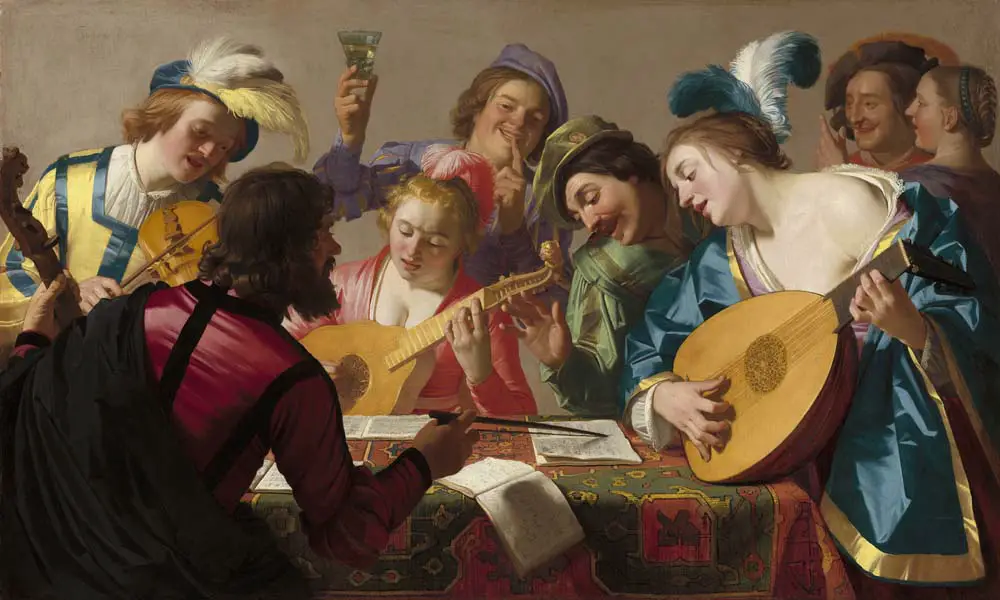Stages of music history.
Music can be defined as the art of combining sounds with silences, following the principles of harmony, melody and rhythm. Its name comes from Greek and means “the art of the muses” who were, in Greek mythology, the inspirers of all forms of art.
Many consider that music was born with humanity:
when the first human being was able to imitate the sounds of nature. Later, they managed to make instruments using stone and bone in principle.
Music has been considered an expression of divine beings, representing the message of nature. Since its beginnings, it has accompanied humanity in various collective activities such as ceremonies to pay tribute to the gods and seek their approval for hunting or fertility, as well as in funerary rituals.
Since its ancient origin, music has been undergoing a large number of changes, particularly in the handling of melody and rhythm. This is how it is possible to recognize several stages or periods in its evolution:
Stage of prehistory and ancient history:
Since the birth of music, human beings have been developing instruments to produce and combine sounds. The first records of musical instruments date back to the Lower Paleolithic and through rituals and dances, music was the way to communicate with the afterlife.
Later in ancient Mesopotamia, music continued to be closely associated with religion and there are records of responsorial songs that were performed accompanied by musical instruments. The Sumerians and Babylonians (cultures located in the plains between the Tigris and Euphrates rivers) had the Nar who sang praises and the Gala who performed laments.
Already in this civilization, harps, lyres, lutes, drums and some string instruments appeared that accompanied the songs. Later, in ancient Egypt, music continued to be closely linked to religion and performances were performed where several musicians played different instruments alongside singers and dancers.
In Greek culture, music transcended religion and was considered an art that influenced the development of human beings. A large number of musical instruments were used such as the shoulder harp, the upright flute, the kithara or the lyre.
Stage of the Middle Ages:
It is at this time, in Western Europe, that we can speak of the true birth of the history of music. This is because there is a record of the first scores associated with Gregorian chants during the papacy of Gregory I in the 9th century.
In these scores the musical notes were represented with symbols known as neumes, where these songs performed by the monks were recorded. Two-voice songs also appear, which are considered the first expression of polyphony.
Around the 13th century in France, motets originated, in which a third voice was added that could sing in another language and the accompaniment of these songs with musical instruments began. Furthermore, between the 12th and 13th centuries, troubadours emerged, who were traveling musicians who composed songs to tell stories in towns and cities.
Related Blog : Evolution of Security Systems in Museums.
modern stage
Because of this, the modern stage is divided into several periods:
Renaissance :
From the 15th century onwards, the arts resurfaced after a period dominated by the church and a large number of cultural manifestations began to emerge. In music, popular composers stand out as well as a cappella songs . Likewise, the first composers of instrumental music emerged, the best known being Palestrina and Josquin des Prez.
Baroque :
It is a style of Italian origin that means “irregular precious stone”, characterized by heavy ornamentation. In the music of the time, instrumental music stands out, with great composers still in force such as Albinoni, Vivaldi, Handel or Bach. Violins began to be used and the famous Stradivarius appeared, made by the Stradivari family.
Classicism :
It is also known as the neoclassical period, where we want to return to the Greek roots in art. For music it is the birth of the symphony and the sonata as well as the emergence of musical instrument factories, particularly the piano. Among the composers of the time, Mozart, Beethoven and Haydn stand out, German opera develops and the genre of classical opera is differentiated from buffa.
contemporary stage:
Starting in the 19th century there was a revolution in the arts and it broke with the era of reason to give more importance to feelings. The artists wanted to express themselves freely, breaking with the conventional schemes for the time and romanticism emerged.
Romanticism : this current proposed that reality could only be grasped through intuition and emotions. Music became one of the main forms of expression of feelings with works such as those of Chopin, Schumann and Tchaikovsky. It is the period of Wagner’s German tragic opera and Verdi’s Italian bel canto.
Modern period : from the beginning of the 20th century until 1945, atonality emerged where dissonant notes were favored. Likewise, the twelve-note system appears in which we work with a scale of twelve notes without hierarchy, so each sound stands out. A representative of this era is the Hungarian composer Bartók.
Contemporary period : starting in 1945, new forms of musical expression appear, such as minimalism that works with few elements, rock or the polyrhythmic sounds of North Africa appearing. Likewise, different rhythms of urban popular music emerge such as jazz, blues, gospel, techno or funky.
Music is also expressed through musical theater, highlighting composers such as Stravinsky. Another branch of music is that associated with the big screen with great soundtracks such as those for King Kong in 1933 by Max Steiner or the great hits of Spielberg and George Lucas set to music by John Williams.
As you can see, music continues to evolve along with the history of humanity, as one of its main forms of expression. Nowadays, technology has left its mark on expressions such as electronic music, House or K-Pop.
